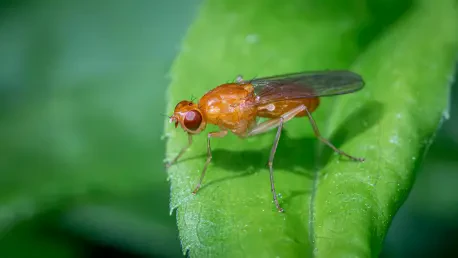Imagine a world where the faintest whiff of an odor can dictate life-or-death decisions, guiding creatures to nourishment or steering them away from peril, and now, a groundbreaking study from the RIKEN Center for Brain Science in Japan, led by Hokto Kazama and his team, has peeled back the layers of this sensory mystery using the humble fruit fly as a model. Published on October 10, 2025, this research dives deep into the neural circuits that enable fruit flies to distinguish between pleasant and unpleasant smells, offering a glimpse into the ancient and vital sense of olfaction. Far from being a mere curiosity, the findings challenge long-held assumptions about how smells are processed in the brain, revealing a complexity that could resonate across species, including humans. This discovery not only enriches the understanding of sensory perception but also hints at transformative applications in fields like technology and medicine, making it a pivotal moment in neuroscience.
Decoding the Science of Smell
The sense of smell, one of the most primal sensory systems, has guided organisms through evolutionary history, shaping behaviors critical to survival. In the recent study, researchers turned to the fruit fly, scientifically known as Drosophila melanogaster, to explore this intricate process. Selected for its relatively streamlined neural structure compared to mammals, the fruit fly still possesses a sophisticated olfactory system with thousands of neurons and countless connections. Kazama’s team employed advanced techniques such as two-photon microscopy to observe brain activity in real time, alongside optogenetic tools to manipulate specific neurons with light. These methods provided an unprecedented look into how olfactory information is received and interpreted, uncovering the mechanisms that allow the tiny insect to evaluate odors. The significance of this choice of subject lies in its balance of simplicity and relevance, offering insights that could mirror processes in more complex organisms while remaining manageable for detailed study.
Beyond the experimental toolkit, the researchers constructed a connectome-based network model, essentially a digital blueprint of the fruit fly’s brain wiring. This computational approach enabled them to simulate how neural circuits process smells, predicting outcomes before testing them in live subjects. The model’s accuracy was striking, aligning closely with experimental results and revealing that the brain doesn’t treat all odors the same way. Instead, it employs distinct strategies to categorize smells based on their value to the organism. This blend of empirical observation and theoretical modeling marks a significant leap forward, providing a clearer picture of olfactory processing at a granular level. Such an approach not only validates the findings through multiple lenses but also sets a precedent for future studies aiming to unravel other sensory mysteries, demonstrating the power of integrating technology with biology to decode the brain’s inner workings.
Neural Pathways for Pleasure and Pain
At the heart of the study lies a fascinating revelation about the fruit fly’s lateral horn, a brain region pivotal to assigning value to odors. The research uncovered that unpleasant smells are processed through a straightforward excitatory pathway, acting as a rapid alert system to trigger avoidance behaviors. This direct mechanism likely evolved to ensure quick reactions to potential threats, such as toxic substances or spoiled food. By mapping the neural activity in this area, the team demonstrated how signals are amplified through feedforward excitation, ensuring that the organism prioritizes safety over deliberation. This finding underscores the brain’s efficiency in handling critical sensory input, where speed can mean the difference between survival and harm, painting a vivid picture of evolutionary adaptation at the neural level.
In stark contrast, pleasant odors follow a more intricate path involving local inhibition within the lateral horn. This process refines the perception of agreeable smells, possibly to encourage sustained interaction with beneficial stimuli like food sources. The study’s use of optogenetics was instrumental here, allowing precise control over neural activity to test hypotheses. For instance, silencing specific circuits could shift a fly’s preference, turning a typically appealing odor into something aversive. This confirmed the existence of separate neural architectures for positive and negative olfactory experiences, debunking the idea that they are merely two ends of a single spectrum. Such a nuanced system highlights the brain’s capacity to tailor responses based on context, ensuring that behaviors are not just reactive but strategically aligned with the organism’s needs, offering a deeper appreciation of sensory complexity.
Implications for Technology and Beyond
The implications of this research stretch far beyond the laboratory, hinting at transformative possibilities for artificial intelligence and other fields. By understanding how the fruit fly’s brain computes the value of odors through distinct circuits, scientists could inspire algorithms that replicate biological sensory processing. Such advancements might enhance technologies in areas like food science, where detecting subtle olfactory cues could improve quality control, or in environmental monitoring, where sensors mimicking neural evaluation could identify pollutants. The study’s digital model of the brain also paves the way for creating virtual replicas—often termed “digital twins”—that simulate neural responses under various conditions. This could reduce the need for invasive experiments while accelerating research, marking a significant step toward ethical and efficient scientific exploration with broad practical applications.
Moreover, the findings hold promise for advancing medical diagnostics, where olfactory processing plays a subtle yet critical role. Conditions affecting smell, often early indicators of neurological disorders, could be better understood through the lens of these neural mechanisms, potentially leading to earlier detection methods. The integration of computational models with experimental data also exemplifies a growing trend in neuroscience, where multidisciplinary approaches yield richer insights. As these tools become more refined, they could unlock further secrets of sensory systems across species, bridging gaps between basic research and real-world solutions. This study, therefore, stands as a beacon of innovation, illustrating how a tiny insect’s brain can illuminate pathways to progress in both science and technology, fostering a future where biological principles inform cutting-edge advancements.
Reflecting on a Sensory Breakthrough
Looking back, the meticulous work by Kazama and the team at the RIKEN Center for Brain Science carved a new path in understanding how fruit flies discern the pleasantness or unpleasantness of odors through distinct neural circuits. Their experiments and models painted a detailed portrait of the brain’s sophisticated approach to sensory input, a testament to the intricate balance of simplicity and complexity in nature. Moving forward, the challenge lies in translating these insights into actionable outcomes, whether by refining AI systems to emulate biological sensory evaluation or by deepening the grasp of olfactory dysfunctions in clinical settings. Exploring similar mechanisms in other organisms could further validate these findings, while collaborative efforts across disciplines might amplify their impact. This research, with its blend of precision and vision, lays a foundation for future inquiries, urging scientists and innovators to build upon these neural discoveries for broader societal benefit.









